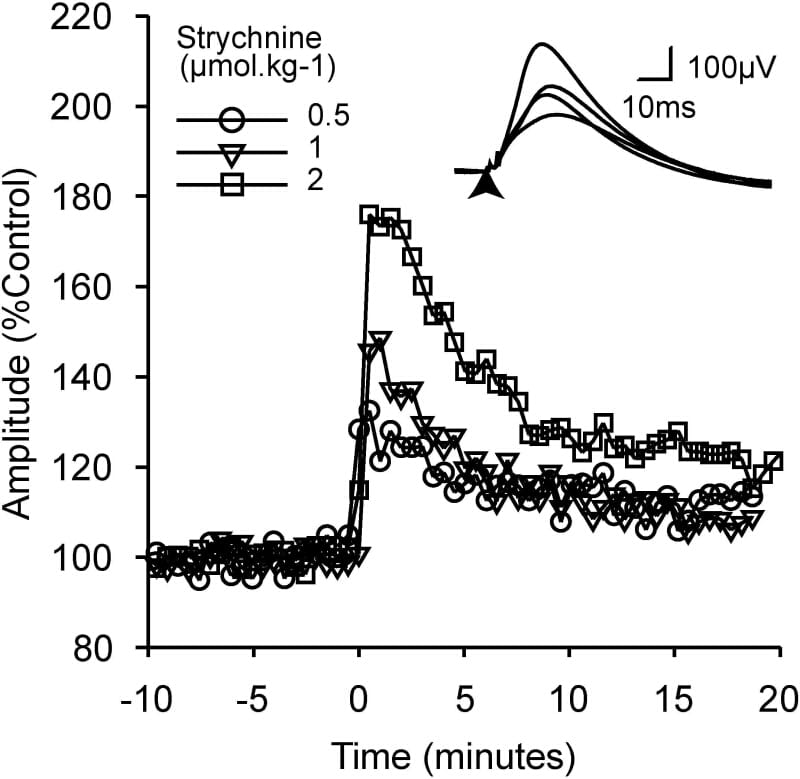Primary afferent depolarization (PAD) is a mechanism that accompanies some forms of pre-synaptic inhibition of the effects of primary afferents on their central targets. PAD is primarily mediated via GABAA-receptors and gives rise to a prolonged depolarization that may be monitored as an electrotonus with a pair of electrodes placed beneath a cut dorsal root (the dorsal root potential, DRP; see Rudomin and Schmidt 1999 for review). The pre-synaptic inhibition that accompanies PAD was shown to be enhanced by low-doses of strychnine in the cat (Eccles et al., 1963). Facilitation of stimulus-evoked DRPs in the presence of strychnine has also been reported (e.g. Jimenez et al., 1987). These results suggest that the DRP-generating spinal circuits are subject to glycinergic control. Experiments were conducted in male Sprague-Dawley rats anaesthetized with urethane (1.25 g/kg i.p.). The trachea, carotid artery and jugular vein were cannulated and the spinal cord was exposed from the low thoracic level to the cauda equina and bathed in warm mineral oil. The cord was transected at mid-thoracic level (T8). Rats were observed to be deeply and stably anaesthetized for at least 1h and were then immobilised with gallamine triethiodide (20mg i.v.) and mechanically ventilated. Level of anaesthesia was monitored and maintained as described in Lidierth & Wall (1996). Heart rate and end-tidal CO2 were monitored and temperature was maintained at 37°C. Systemic administration of strychnine was observed to have two effects. At low doses (0.2-2.0 μmol/kg i.v.), the DRPs evoked by electrical stimulation of neighbouring roots were dose-dependently enhanced (Fig. 1). In addition, the spontaneous DRPs that occur at approximately 10Hz in the spinally transected rat (Lidierth and Wall, 1996) were increased in amplitude. At high doses of strychnine (2.0-5.0 μmol/kg i.v.), these spontaneous DRPs dominated and stimulus-evoked DRPs were reduced in amplitude. These data suggest that strychnine may block a tonic glycinergic inhibition that is intrinsic to the spinal cord and that serves to dampen both spontaneous and evoked DRPs. Evidence for tonic glycinergic inhibition of deep dorsal horn neurones has recently been presented (Cronin et al., 2004).The present data suggest that these neurones include those responsible for generating PAD.
King's College London (2005) J Physiol 565P, C111
Communications: Strychnine-sensitive mechanisms regulating primary afferent depolarization in the rat spinal cord
Lidierth, Malcolm ;
1. Physiology, King's College London, London, United Kingdom.
View other abstracts by:
Fig. 1. Dose-dependent effects of strychnine on the amplitude of the DRP evoked on the L5 dorsal root by a submaximal stimulus to the L6 root. The inset shows averaged DRPs from the control period and for each of the doses of strychnine
Where applicable, experiments conform with Society ethical requirements.

